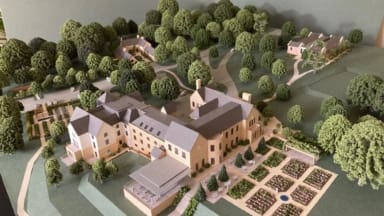
Scale models are as old as architecture. Despite the rise of 3D computer-generated visualisations, the craft of model-making still has relevant role to play. Accurate and realistic scale models allow designers to present their ideas for assessment and provide a true sense of how the design, with all its elements will feel in reality. The exquisite miniature representations remain an essential tool to facilitate the creative process for architects and designers to help communicate ideas to clients.
A graduate of the University for the Creative Arts (UCAS) and St Alban’s School of Art, Mark Davies has been making architectural models for 24 years. He specialises in creating high-quality models for architects, garden/landscape designers, sales, master planning and urban design industries.
Davies confirms suspicions that the advancement in computer generated imaging has resulted in a steady decline of scale modelling. Moreover, “After the pandemic, the workplace changed and people became more screen orientated and less tangible”, notes Davies.
Though in his years of model making, Davies has noted a shift. “…it is only in the last few years that landscape designers are commissioning models from me in their own right. In the past, the landscape was often integral to the scheme, but the emphasis was on the architecture. This year in fact, I have made more landscape models, which is a joy as my passion is horticulture and landscape designs”.
Garden designer, James Alexander Sinclair who commissions Mark Davies to make models for clients of his garden designs (as pictured) said: “Models are good for some gardens as much easier to read than a plan and are always irresistible”. A point proved by the buzz of activity on his Instagram on the posting of his commissioned models.
Not just an artful artefact, for landscape designers physical models can be valuable working tool. “It’s an awfully lot easier (and cheaper) to change the model, rather than the land”, adds Davies.
In terms of materials, eco-friendly is the way forward. “I have seen an increase in wood models, which are beautifully tactile and are beautiful keepsakes. I try to be as sustainable as I can. Craftsmanship is a driving force for me as handmade objects are becoming scarcer”, explains Davies. Even though he has no use for them as he prefers to work with wood and card, Davies said that 3D printers can add another dimension to models for commercial model makers.
For those keen to take up a career in model making, Davies said: “My passion has always been to make things and it was delight to find I could pursue a career in model making. If someone wanted to get into model making now, there are some incredible courses around, but getting straight into industry via apprenticeship would be invaluable”.

